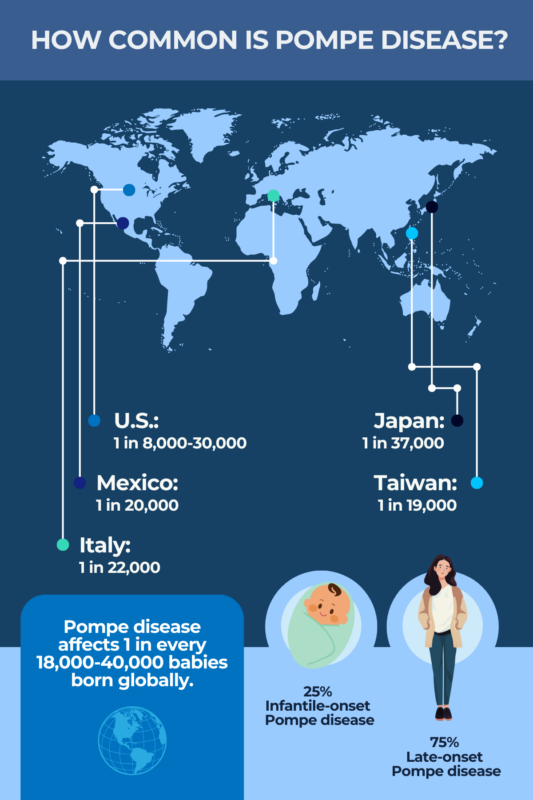Pompe disease prevalence
Last updated March 20, 2025, by Lindsey Shapiro, PhD

Determining the exact Pompe disease prevalence is difficult because it’s a rare condition that can be challenging for doctors to accurately diagnose. But with advances in newborn screening programs (NBS) that test babies for rare genetic diseases at birth, scientists are starting to get a better picture of how many people are living with the neuromuscular condition.
Pompe disease is a rare lysosomal storage disorder — a group of diseases broadly characterized by a lack of enzymes needed to break down substances in the body, causing their toxic accumulation.
In Pompe, mutations in the GAA gene cause a lack of functional acid alpha-glucosidase enzyme, or GAA. That enzyme is normally responsible for breaking down a large sugar molecule called glycogen. Consequently, glycogen accumulates to toxic levels, especially in muscle cells, leading to symptoms of progressive muscle weakness and low muscle tone.
How many people have Pompe disease?
Due to inherent challenges in accurately diagnosing rare diseases, it’s difficult to know the exact number of people with Pompe worldwide. Historically, estimates based on genetic data placed Pompe disease incidence somewhere around 1 in 40,000 people.
In recent years, countries including the U.S. have started to add Pompe disease to their NBS programs, which has enabled more accurate estimates to be made. Newer data emerging from these programs generally reflect that Pompe disease occurs more frequently than was previously thought.
An analysis in early 2024 used NBS data from more than 11 million newborns, screened across eight countries between 2010 and 2022. It found the birth prevalence of Pompe to be 1 in 18,711, or 5.3 cases of Pompe for every 100,000 births. Researchers believe this estimate is conservative, as it only accounts for cases captured via NBS at birth.
In a 2021 study, the genetic prevalence of Pompe disease was estimated based on the proportion of people in the general population who had likely disease-causing mutations. Those results suggested that Pompe has a higher predicted genetic prevalence, of 1 in every 23,232 people, than previously believed. The earlier predicted prevalence was 1 in 40,000 people.

Geographical differences
In the most recent studies, the birth prevalence of Pompe disease was found to not significantly vary by geographical region.
Emerging data from existing NBS programs across the globe should help scientists more accurately determine the true geographical differences, if any, in Pompe disease incidence.
Nevertheless, previous studies have suggested that the incidence of Pompe disease may vary by geographical region and across ethnic groups. Among the populations historically reported to be at a higher risk are people of African American, Taiwanese, Dutch, and Israeli descent.
In the 2021 study, the highest predicted genetic prevalence of Pompe disease was observed in East Asian, non-Finnish European, Ashkenazi Jewish, African/African American, and Latino/Admixed American populations.
The most recent prevalence at birth data available for some countries worldwide include:
- the U.S., where incidence is estimated at 1 in 8,000 to 1 in 30,000, depending on the state
- Japan, estimated at 1 in 37,000
- Taiwan, estimated at 1 in 19,000
- Mexico, estimated at 1 in 20,000
- Italy, specifically northeast Italy, where incidence is estimated at 1 in 22,200.
Prevalence of infantile-onset Pompe disease
In infantile-onset Pompe disease, known as IOPD, disease-causing mutations lead to very little or completely absent GAA enzyme activity — usually less than 1% of normal. In the more severe type of the disease, its symptoms are usually evident in the first months of life.
About one-quarter of Pompe cases are IOPD. Data on the incidence of infantile-onset Pompe disease has been highly variable, with recent estimates reporting the birth prevalence of IOPD to be 1 in 126,118, or 7.9 per 1 million babies born.
Findings for IOPD in particular vary geographically, with reported incidence rates in some U.S. states and Japan being approximately 1 in 200,000 to 1 in 300,000. Higher incidences have been reported in the state of Missouri in the U.S., at 1 in 46,700, and Taiwan at 1 in 67,047.
Prevalence of late-onset Pompe disease
Generally considered the more mild form of the condition, late-onset Pompe disease (LOPD) is characterized by GAA enzyme activity up to 40% of normal.
Of the types of Pompe disease, LOPD is the most common, accounting for about three-quarters of cases. Recent analyses place the birth prevalence of LOPD at 1 in 21,902, or 45.6 per 1 million births.
Are rates of Pompe disease increasing?
Recent research reflects a higher incidence of Pompe disease than earlier estimates. However, that does not necessarily mean that more people are born with the disease now than in the past.
Advances in the ability to accurately diagnose Pompe disease early in life mean that more cases that may have been previously missed can now be accurately captured. Over time, with approaches like NBS in place worldwide, scientists will be able to better determine the condition’s frequency, or the true Pompe disease prevalence.
Pompe Disease News is strictly a news and information website about the disease. It does not provide medical advice, diagnosis, or treatment. This content is not intended to be a substitute for professional medical advice, diagnosis, or treatment. Always seek the advice of your physician or other qualified health provider with any questions you may have regarding a medical condition. Never disregard professional medical advice or delay in seeking it because of something you have read on this website.
Related articles






